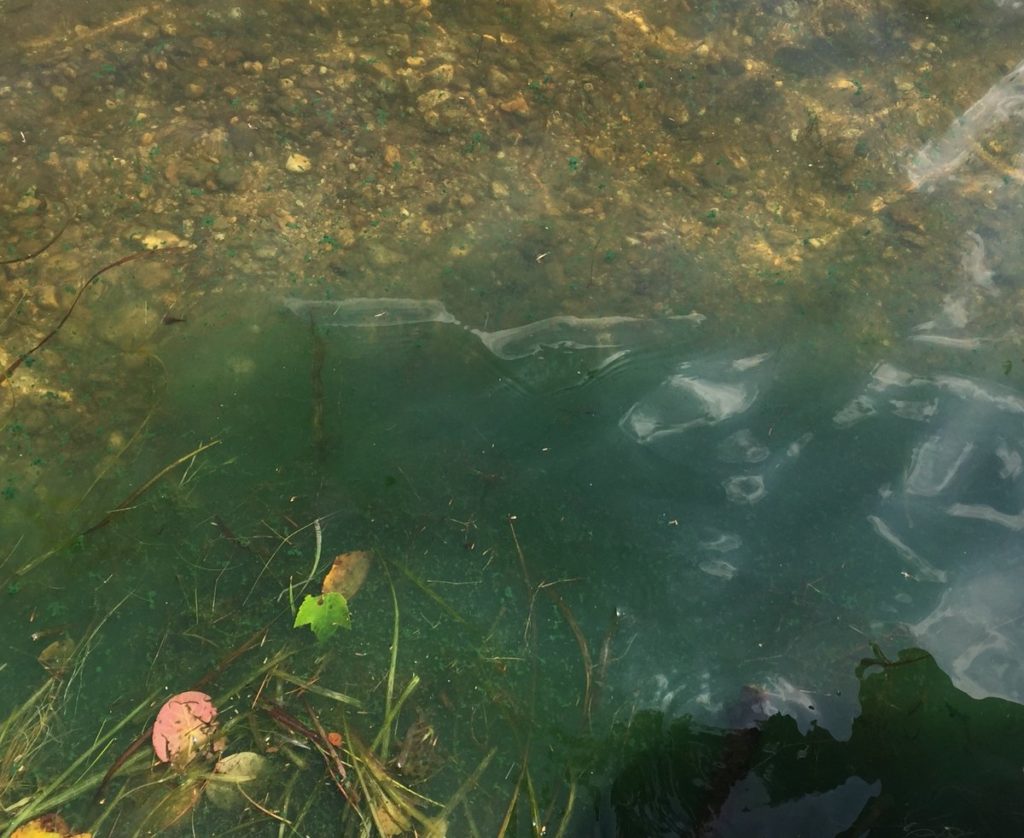By Susan Marks and Roberta MacCarthy
Freedom—May 13, 2019—Add cyanobacteria to the list of issues that should be on the radar of Ossipee Lake property owners. On the rise around the state and found three times last year in our lake, this naturally-occurring but potentially toxic phenomenon is prompting public information meetings like the Wolfeboro Water Summit we attended on May 11.
Presented by the Wentworth Watershed Association, the meeting featured presentations by three state experts on the ecology of cyanobacteria and the challenges facing lake communities. It was followed by a panel discussion and audience Q&A.
A division of microorganisms related to bacteria, but capable of photosynthesis, cyanobacteria represent the earliest known form of life on the earth. They are an integral part of our natural ecosystem that were known for years as “blue-green algae”; something seemingly benign that came and went in the lake at random during the summer.
In the past decade, however, our lakes have experienced warmer temperatures and increased phosphorus sediment, two ingredients favorable to cyanobacteria’s development. Now that there’s more cyanobacteria visible around the state, there’s greater scrutiny.
Cyanobacteria are stable in the spring, when they reside under low light conditions in sediment at the bottom of a lake. But the natural lifecycle of these microcosms causes them to grow as the lake water warms. By August they begin to float upward and aggregate, creating surface blooms like the ones seen last year in Danforth Pond and Berry Bay.

Potential for Toxicity
While most cyanobacteria compounds are harmless, many are toxic. A bloom of harmful cyanobacteria, known as HCB, can release enough toxins—in the water and even through the air—to cause neurological damage. Once a bloom appears, it can take one to two weeks to dissipate.
The blooms found last year in Berry Bay and Danforth Pond were quite different from one another, according to DES official Amanda McQuaid, who spoke with Ossipee Lake Alliance by email this week.
In Berry Bay, there was a short surface accumulation of a genus called Anabaena (a.k.a. Dolichospermum) near the dam, where water currents likely helped both accumulate it and move it out of the lake quickly. The blooms at Danforth appeared to be more severe, of a type called Oscillatoria (a.k.a. Planktothrix).
Both of these types of cyanobacteria are known to produce an array of toxins. While the blooms in both bodies of water had low or non-detectable levels of Microcystin, a common toxin that affects the liver, both were found to have the potential to produce anatoxin, which affects the nervous system. Anatoxin is much less stable than microcystin and can degrade faster, but it has been attributed to dog deaths.
Since most cyanobacteria produce at least one type of toxin, and since it’s impossible to assess the risk without testing samples in a lab, the state advises that all cyanobacteria be considered potentially toxic. That means affected areas should be posted as off-limits until the facts can be sorted or the blooms naturally dissipate.
At present, the state can only test for a few types of toxins, although it is conducting trials for others. Add to this the fact that there is no simple explanation for why cyanobacteria blooms appear, and you have a challenge for lake communities like ours to understand the phenomenon well enough to do something about it.
Since cyanobacteria thrive on phosphorus, a discussion would be logical about the amount of phosphorous entering the lake through runoff. Simply put, runoff occurs anytime the shoreline can’t absorb more water. That happens during times of heavy rain, but also occurs in early spring when the snow starts melting before the ground thaws. The more phosphorus there is on land, the more will end up in the lake via runoff to feed the development of cyanobacteria.
For years, environmental groups have pointed to the need to reduce phosphorus in regard to water quality by replacing failed or failing septic systems, avoiding lawn fertilizers, and reducing impervious surfaces. That sound advice can also be applied to the potential to limit the development of cyanobacteria—even though the presence of excess nutrients may not provide a complete explanation for why cyanobacteria occur.
For the Ossipee Lake community, the challenge of cyanobacteria is similar to the challenge of variable milfoil: how to live with it while attempting to control it. Per the experts at the Wolfeboro Summit, what’s needed is more research and monitoring as part of watershed planning, and new models that can help anticipate blooms and manage the issues they cause.
Ossipee Lake Alliance will continue to report on this issue and will hold a public meeting on the topic later this year. Meanwhile, additional information is available from the state at this website.

Thank you for attending and reporting.